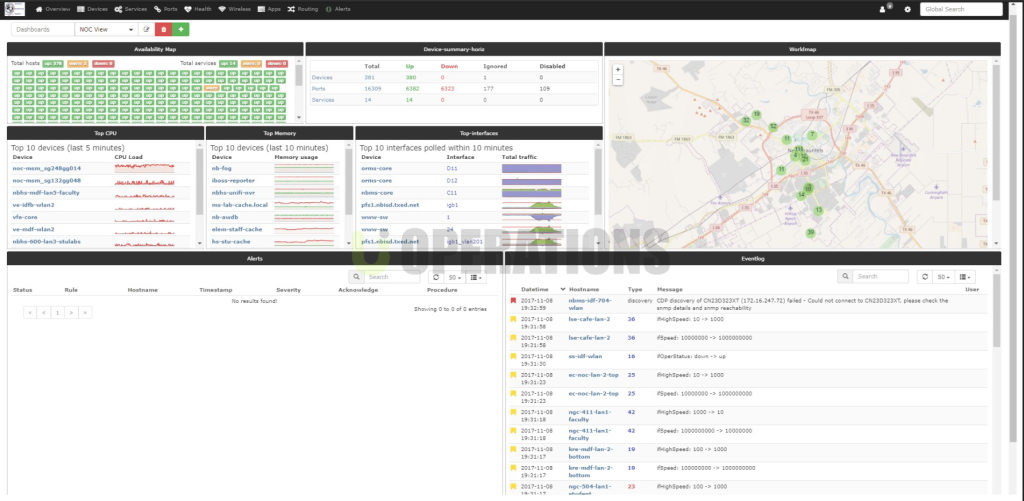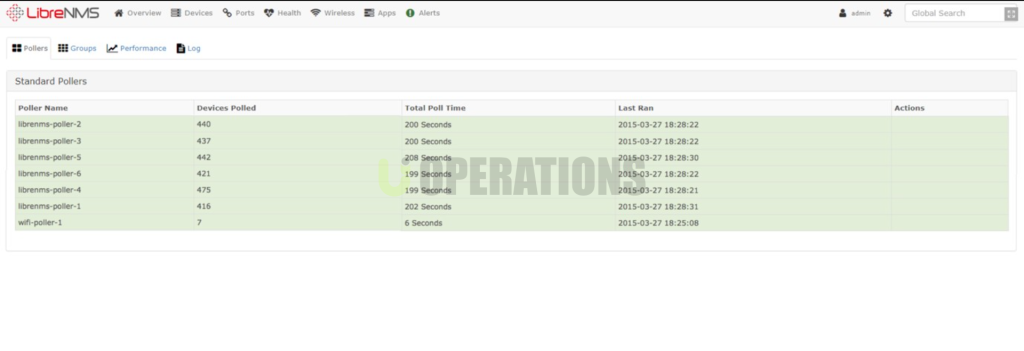Portfolio Details
LibreNMS Deployment
Price: 1500$
Duration: 2 weeks
01
introduction
This document outlines the deployment process and key considerations for the Limbre Network Management System (NMS), which was implemented to meet the specific requirements of a client’s network monitoring and management needs. Limbre NMS is a comprehensive solution for monitoring network performance, detecting issues, and managing network infrastructure in real-time. The system was deployed to provide the client with enhanced visibility, control, and optimization of their network operations.
02
Client Requirements overview
The client approached us with a clear set of requirements for deploying an NMS that could effectively monitor their complex network infrastructure and provide insights into both operational and performance metrics. Their network was growing rapidly, and they needed a solution that could scale with their expanding resources and maintain a high level of performance, security, and reliability.
Specific client requirements included:
- Comprehensive Network Monitoring: The client required a solution capable of monitoring their entire network infrastructure, including routers, switches, firewalls, and servers, in real time.
- Proactive Issue Detection: The need to detect potential network issues proactively, before they could impact performance, and to provide clear alerts and actionable insights.
- Centralized Management: The client desired a centralized platform to monitor and manage all network devices and services from a single interface, simplifying troubleshooting and management.
- Scalability: As their network was expected to grow, the client needed an NMS that could scale to accommodate new devices and more extensive infrastructure.
- Security and Compliance: The solution had to meet stringent security and compliance requirements to ensure the confidentiality, integrity, and availability of data.
- Reporting and Analytics: Detailed reporting capabilities were necessary for historical analysis, performance trends, and compliance documentation.
- Integration with Existing Tools: The client needed to ensure that the NMS could integrate seamlessly with their existing ticketing, ITSM, and alerting systems.
03
Limbre NMS Architecture Design
The Limbre NMS was deployed with a focus on meeting the client’s specific network management needs. The architecture was designed to provide scalability, reliability, and flexibility, with consideration given to the client’s infrastructure and business continuity needs.
Key Components of the Limbre NMS Architecture:
- Centralized Monitoring Server:
- A centralized monitoring server was established to host the Limbre NMS application. This server acts as the core of the deployment, responsible for aggregating data from all monitored devices, applying alerting rules, and generating reports.
- The server was deployed in a highly available configuration, ensuring that the monitoring system remains operational even if one server goes down.
- Network Device Integration:
- The NMS was integrated with various network devices such as routers, switches, firewalls, and servers across the client’s infrastructure.
- SNMP (Simple Network Management Protocol), NetFlow, and Syslog were employed for data collection from these devices, enabling real-time monitoring of device health, traffic, and performance metrics.
- Alerting and Notification System:
- The NMS was configured to send proactive alerts based on specific thresholds for device performance, connectivity, and availability. These alerts could be customized based on severity levels (e.g., critical, warning, informational) and delivered via email, SMS, or integrated with the client’s existing ticketing systems.
- An automatic remediation feature was included, where certain alerts triggered predefined actions to resolve common issues, such as restarting a service or clearing a cache.
- Reporting and Dashboards:
- Custom dashboards were created for different user roles, offering at-a-glance views of network health, device status, and traffic analysis.
- Detailed reporting capabilities were configured to allow the client to generate custom reports based on specific parameters (e.g., uptime, performance trends, traffic statistics) for compliance auditing and internal analysis.
- Distributed Architecture for Scalability:
- To ensure scalability, the deployment architecture supported distributed monitoring. This allowed the NMS to monitor additional devices by adding more collectors or distributed agents as the client’s network expanded.
- Load balancing and failover strategies were implemented to ensure high availability of monitoring services.
- Security Measures:
- Access control was configured to restrict users based on roles, ensuring that only authorized personnel could modify configurations or access sensitive information.
- All communication between the NMS server and network devices was encrypted using secure protocols like SSH and HTTPS to prevent unauthorized access or data interception.
- Audit logs were generated for all configuration changes, ensuring accountability and enabling auditing for compliance purposes.
- Integration with Third-Party Systems:
- The Limbre NMS was integrated with the client’s existing IT Service Management (ITSM) tools, such as ServiceNow, and alerting systems like PagerDuty, to streamline incident management and reduce response times.
- The system was also integrated with the client’s network security monitoring tools to provide a holistic view of the client’s security posture.
04
Deployment Process
- Initial Planning and Design:
- The deployment process began with understanding the client’s network topology, device inventory, and specific monitoring requirements.
- A detailed architecture and deployment plan were created, taking into account the client’s needs for scalability, availability, and security.
- Installation of Limbre NMS:
- The Limbre NMS software was installed on the designated server, following best practices for installation and configuration.
- The server environment was configured for optimal performance, including resource allocation (CPU, memory, storage) and network settings (firewall, DNS, etc.).
- Network Device Configuration:
- Network devices were configured to send SNMP, NetFlow, and Syslog data to the NMS server.
- Monitoring templates were applied to each device type to ensure that relevant metrics (e.g., CPU load, memory usage, network traffic) were collected.
- Custom Configuration and Testing:
- The NMS was configured to meet the client’s specific needs, including custom alerting rules, dashboards, and reporting parameters.
- Testing was conducted to ensure proper data collection, alert generation, and integration with third-party systems.
- Training and Knowledge Transfer:
- The client’s IT staff was trained on how to use the NMS, interpret data from dashboards, respond to alerts, and generate reports.
- Documentation was provided, including standard operating procedures (SOPs) for monitoring and troubleshooting.
- Go-Live and Post-Deployment Support:
- The system was fully deployed, and the NMS was brought live in the production environment.
- Post-deployment support was provided to ensure smooth operations and address any issues during the initial usage period.



05
Challenges and Mitigations
Several challenges were encountered during the Limbre NMS deployment:
- Device Compatibility: Some older devices in the client’s network had limited SNMP support or incompatible versions. This was mitigated by updating device firmware and using alternative monitoring methods such as agents or custom scripts for unsupported devices.
- Alert Noise: Initial configuration resulted in excessive alerts, especially from devices with fluctuating performance. This was resolved by fine-tuning alert thresholds and implementing filtering rules to reduce noise and only notify on meaningful events.
- Scalability Considerations: The client’s growing network required careful planning for scaling the NMS. Distributed collectors were deployed to handle the increased load, ensuring smooth expansion.
06
conclusion
The Limbre NMS deployment was successfully executed, providing the client with a powerful tool to monitor, manage, and optimize their network infrastructure. By providing real-time insights, proactive issue detection, and centralized management, the NMS significantly improved the client’s ability to ensure network uptime and reliability.
The system’s scalability allows it to grow with the client’s network, while its integration with existing tools and security features ensures that it meets the client’s operational and compliance requirements. This deployment has set a strong foundation for enhanced network performance, reduced downtime, and improved overall efficiency.

